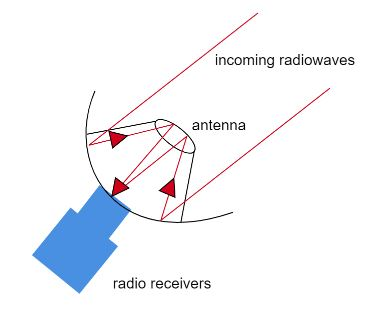
Answer
366k+ views
Hint: We are asked to state the construction and working of a radio telescope. We can start to answer this question by mentioning what a radio telescope is and why is it being used. We can then move onto the construction, working and the advantages and disadvantages of using one.
Complete answer:
Radio telescopes, as the name suggests are telescopes that help us to view the radio waves coming from space. Telescopes have been an important invention to mankind. They helped us understand the universe better and the earth is not the center of the universe. Radio telescopes are used to study the naturally occurring radio waves from the stars and other astronomical bodies.
There are four parts in a radio telescope. Namely the reflector, antenna, amplifier, and receiver. The large dish you see in the telescope is the reflector that is used to focus the radio waves. The antenna is placed in the middle of the dish. The waves focused by the dish are forwarded to the antenna. After the antenna absorbs the radio waves, they are forwarded to the amplifier so that the strength of the signal increases.
After the amplification process, the amplified signal is forwarded to the receiver. The receiver also amplifies the signal and it is integrated. This data or signal is then sent to a computer that records and processes the data. Often, the data is converted into a map which helps us by showing the area of dense and less dense waves.

Note: Radio astronomy began when an engineer randomly came across the radio waves that come from naturally occurring objects in space and not just from our creations. Radio telescopes provide very important information about the astronomical bodies that are alternate to that seen with the optical telescope. They help us learn about the parts of the universe that are not yet discovered by the optical telescope.
Complete answer:
Radio telescopes, as the name suggests are telescopes that help us to view the radio waves coming from space. Telescopes have been an important invention to mankind. They helped us understand the universe better and the earth is not the center of the universe. Radio telescopes are used to study the naturally occurring radio waves from the stars and other astronomical bodies.
There are four parts in a radio telescope. Namely the reflector, antenna, amplifier, and receiver. The large dish you see in the telescope is the reflector that is used to focus the radio waves. The antenna is placed in the middle of the dish. The waves focused by the dish are forwarded to the antenna. After the antenna absorbs the radio waves, they are forwarded to the amplifier so that the strength of the signal increases.
After the amplification process, the amplified signal is forwarded to the receiver. The receiver also amplifies the signal and it is integrated. This data or signal is then sent to a computer that records and processes the data. Often, the data is converted into a map which helps us by showing the area of dense and less dense waves.

Note: Radio astronomy began when an engineer randomly came across the radio waves that come from naturally occurring objects in space and not just from our creations. Radio telescopes provide very important information about the astronomical bodies that are alternate to that seen with the optical telescope. They help us learn about the parts of the universe that are not yet discovered by the optical telescope.
Recently Updated Pages
10 Examples of Evaporation in Daily Life with Explanations

10 Examples of Diffusion in Everyday Life

1 g of dry green algae absorb 47 times 10 3 moles of class 11 chemistry CBSE

What is the meaning of celestial class 10 social science CBSE

What causes groundwater depletion How can it be re class 10 chemistry CBSE

Under which different types can the following changes class 10 physics CBSE

Trending doubts
Fill the blanks with the suitable prepositions 1 The class 9 english CBSE

Which are the Top 10 Largest Countries of the World?

How do you graph the function fx 4x class 9 maths CBSE

Who was the leader of the Bolshevik Party A Leon Trotsky class 9 social science CBSE

The Equation xxx + 2 is Satisfied when x is Equal to Class 10 Maths

Differentiate between homogeneous and heterogeneous class 12 chemistry CBSE

Difference between Prokaryotic cell and Eukaryotic class 11 biology CBSE

Which is the largest saltwater lake in India A Chilika class 8 social science CBSE

Ghatikas during the period of Satavahanas were aHospitals class 6 social science CBSE




